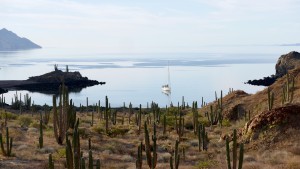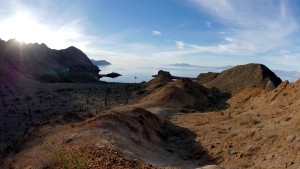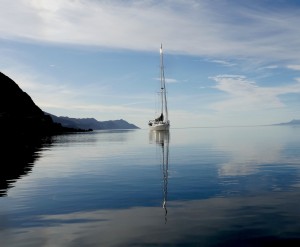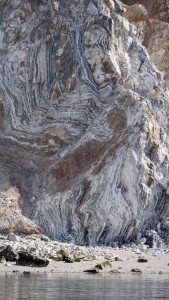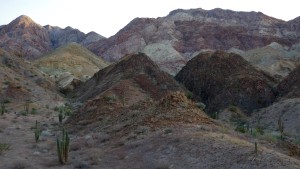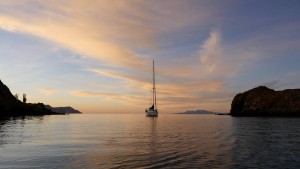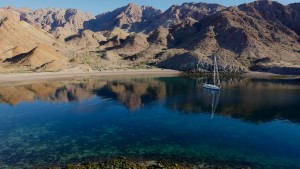This pretty little cove is the only place you can anchor along the west coast of the island. Otherwise it is an impressive mountain ridge that reminds us of mountains in drier parts of Nevada. A vein of red up on the peak just north of us stands out in the nearly bare rock and down at the water level, darker stone is streaked with veins of white. The hook of shore that embraces us to the east is crowned with a classic, cardon cactus. It stands like a familiar marker of a blue ribbon anchorage, like the lone cactus at the saddle around from Dog Bay on Isla Tiburon. We’ve left the mountains, but here at least we have familiar landscapes at the edge of the sea.
The results about Diana’s Uncle Tom, came yesterday. The tumor in his brain, stage four, aggressive. This evil thing developed quickly, and they can only guarantee that they were not able to get all of it. This has been a hard test for Diana, who dearly loves her uncle, unabashedly claiming status as the favorite niece (he makes each one feel they have the title). If she were in Montana, she would have booked a flight, been there when Camille and her Uncle Joe came to see their little brother. To get there from here we would have to sail backward, downwind to Santa Rosalia where the boat could be kept safely. Rent a car, drive to Loreto. It’s doable, but it’s a big lift. We’ve just begun. We will turn back in a few weeks. The fact is that there is time, that right now the doctors need to do their thing, the long shot trial treatment he only qualified for because his tumor is the worst kind.
All this comes as we find ourselves further and further away from the usual communication infrastructure. We connect now only by satellite and it’s pretty good, better than it would have been just a couple years ago, but as days go by and we’ve seen only two other boats, and a handful of panga fishermen, we are very aware of how remote this beautiful part of the world is. My computer crashed, so this iPad is our only link, and Diana is feeling the distance from family and friends that weighs against her passion for this adventure. We feel our friends going on with lives that are very different than whatever this will be. There is something oddly unsettling about the idea that a trip has been planned to Bali. It will takes us four years, at least, to get there as we wait out the seasons and visit the places in between. It’s not just that sailing is slow, our top speed is about twelve miles an hour, eight is more typical, but we are at the mercy of the wind in the most absolute sense. So if it’s going to blow hard for a week to the point that beating against the seas would be pointless or even dangerous, we have no choice but to hide out until it stops. We have to make sure when we move that we know where we’re going to hide when the next norther sets in, or the next cold front makes a surprise visit. A place where our anchor can hold us. It’s the waves that are the enemy, not really the wind. Though the 39 knots gusts that accompanied the last front shook Allora and tipped her over and strained her anchor bridle, our little hurricane hole (Puerto Don Juan) was pretty impervious to the big rollers we could see smashing out at the point, and it wasn’t too bad. We just can’t afford to get it wrong and get caught on the wrong side of an island. This will be the same thing on a much bigger scale as we make our way from Mexico to Central America, passed the infamous Gulf of Tehuantepec where gail warnings with 40 knot winds and huge seas are more common than the rare two day weather windows. Then there is the big blow that drives our schedule as well; hurricane season starts in June or July and doesn’t quit til November, when it picks up in the southern hemisphere.
We sailed to this little cove from Puerto Don Juan. Flat water, and a quick port tack, the wind freshened to 20 knots just as we arrived on a beam reach. The hydrogenerator was cooking, putting out thirty amps plus twenty from the solar panels. Power has not been a problem here in sunny Baja. In fact, I put away our extra solar panel because it was unnecessary. We haven’t been plugged in since we left La Paz back in January, and still our batteries are regularly topped off. Between solar that just gets better with spring coming, the hydrogenerator and two alternators on engines when we occasionally have to motor, or power in and out of anchorages, or detour to do a little fishing or whale watching, we’re set. Our biggest power eater is making water, which costs us about 37Ah for thirteen gallons of fresh water. We decided not to top off in Santa Rosalia because their water was so hard. We took a little and diluted it with our own. We’re careful with water, mainly because we don’t like the noise of the watermaker running. No doubt, compared to some of our fellow sailors here in Baja (a few don’t carry watermakers and have to haul it onboard), we are pretty fresh water rich. It’s pretty cool, using sunshine and motion to provide ourselves with showers and drinking water.
We’ve seen just two other boats up in the Northern Sea. One was a fancy trawler named Salispuedes, after the anchorage where she was moored. The owners, retired farmers from Great Falls, took me fishing in their very tricked out fishing skiff, and taught me a few things that have significantly improved my fish catching. The second was a sailboat singlehanded by a gentleman (kackies, belt and long sleeved polo shirt) from Vancouver island, who shared Puero Don Juan for the big blow.
